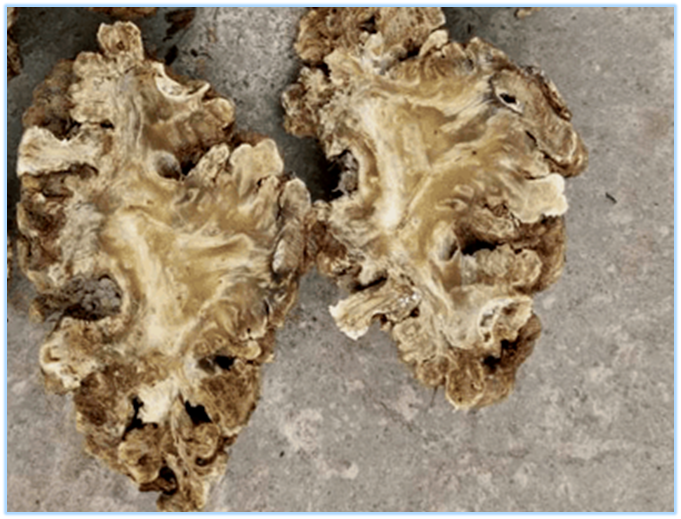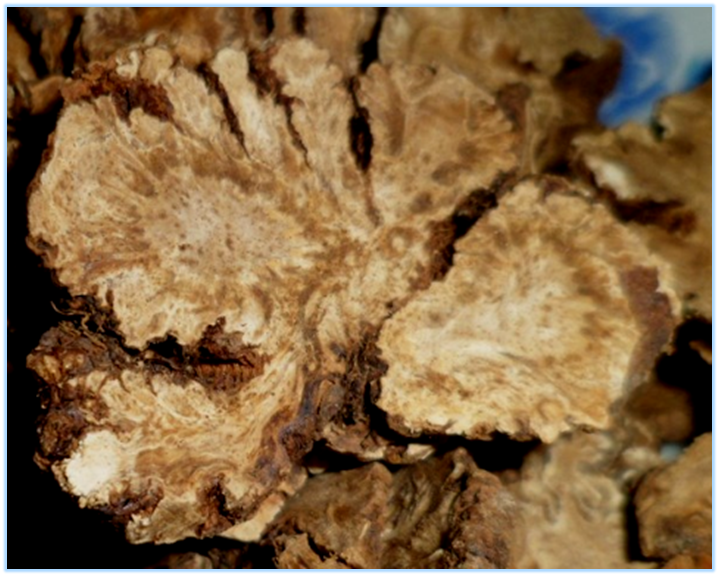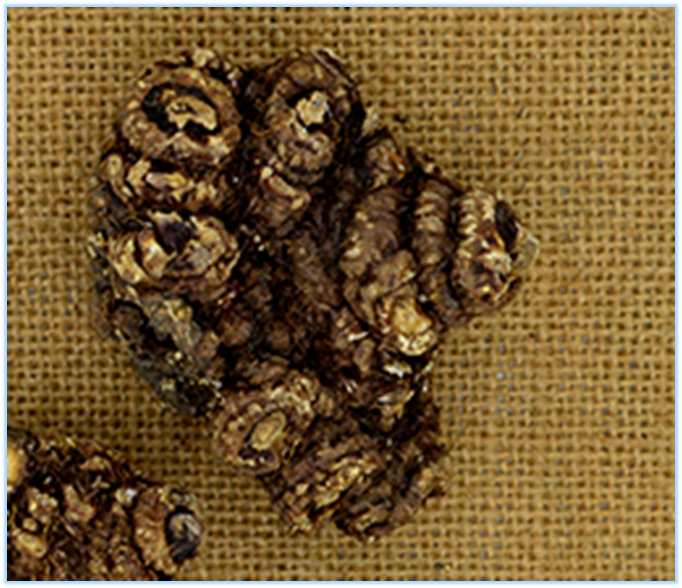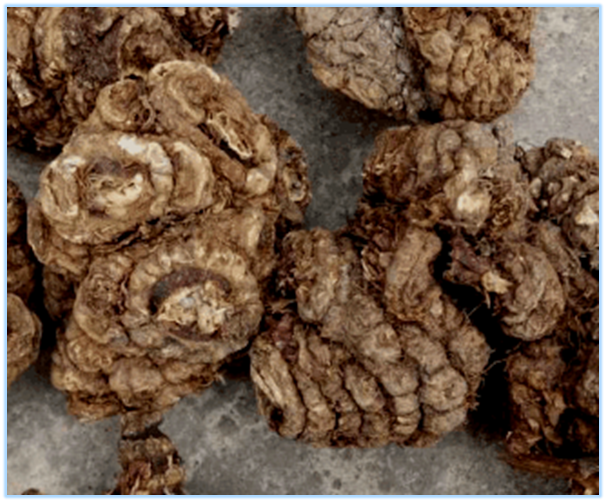
Chuanxiong (Ligusticum chuanxiong) is a commonly used medicinal herb in clinical practice, first recorded in the “Shennong Bencao Jing” (Shennong’s Classic of Materia Medica). It is classified as a medium-grade herb, originally named Xiong, and is primarily produced in Sichuan, Guizhou, and Yunnan provinces. Over time, the production in Yunnan and Guizhou has gradually declined, with Sichuan becoming the main production area, hence the name Chuanxiong.
This herb is the dried rhizome of the plant Ligusticum chuanxiong, belonging to the Apiaceae family. It is harvested in summer when the nodes on the stem are prominently protruding and slightly purplish. After removing the soil, it is sun-dried and then roasted, followed by the removal of the fibrous roots. Impurities are sorted out, and the herb is soaked in water, sun-dried, moistened, sliced, and dried again. For wine-prepared Chuanxiong, the slices are evenly sprayed with yellow wine, slightly moistened, and then stir-fried in a pot until slightly charred, then cooled.

This herb has a pungent and warm flavor, and it enters the Liver (Gan), Gallbladder (Dan), and Pericardium (Xinbao) meridians. Its pungent and slightly bitter taste can relieve stagnation and regulate menstruation; it is moistening and aromatic, capable of harmonizing the blood and regulating Qi. It is effective for both types of headaches, and it is particularly good at nourishing the Liver and dispelling wind-cold; it can also promote the flow of Qi and blood, preventing the depletion of Yin and the vital energy. Its functions include invigorating blood circulation, promoting Qi flow, dispelling wind, and alleviating pain. It is primarily used for irregular menstruation, dysmenorrhea, abdominal pain, chest and lateral pain, traumatic swelling and pain, headaches, and rheumatic pain.
This herb ascends to the head and descends to the blood sea, serving as a guide for the Gallbladder meridian. It is a Qi herb in the blood, elevating Yang and relieving stagnation, moistening the Liver and nourishing its deficiency, ascending to the head, descending to the blood sea, harmonizing blood circulation, promoting Qi flow, dispelling wind, and resolving stasis. It treats all diseases caused by wind and wood.
It treats all types of wind, Qi issues, fatigue, and blood conditions, replenishing the five types of fatigue, strengthening the muscles and bones, regulating various meridians, breaking up blood stasis, nourishing new blood, promoting flesh growth, and addressing issues like epistaxis, hematuria, hemorrhoids, brain abscesses, scrofula, sores, and pus discharge. It specializes in nourishing blood and treating headaches effectively. It promotes blood circulation in the blood sea, opens the Liver meridian, breaks up blood stasis, and helps in postpartum recovery, treating conditions like hemoptysis, epistaxis, hematuria, hematochezia, and menorrhagia.
Chuanxiong ascends to the head and descends to the blood sea, making it a sacred herb for treating blood deficiency headaches. Chronic illnesses often involve stasis, and difficult-to-treat conditions cannot be separated from this herb. Chuanxiong ascends to the head, opens up stagnation, and regulates menstrual flow. It can invigorate blood and resolve stasis while promoting Qi flow. When Qi and blood are unobstructed, diseases will not occur. It is often used in conjunction with Danggui (Angelica sinensis) not only for its blood-nourishing properties but also for its effectiveness in promoting Qi.
Those with Yin deficiency and excess heat, as well as individuals with weakness, should avoid using it. In blood formulas, it can assist in blood circulation, but excessive use can lead to dispersal and should not be taken for prolonged periods.

Common herbal combinations include:
With Qianghuo (Notopterygium incisum): Chuanxiong ascends to the head, making it a key herb for treating headaches. For stubborn headaches caused by wind-cold, Liver fire, phlegm turbidity, and blood stasis, it can be combined with Qianghuo to enhance pain relief, treating both exterior and interior headache conditions.
With Danggui: These two herbs form a famous formula called “Buddha’s Hand Powder” (Foshou San). Danggui is moistening and blood-nourishing, while Chuanxiong invigorates blood and promotes Qi, allowing for blood nourishment without stagnation and blood activation without excessive speed. Blood deficiency often accompanies blood stasis, making Buddha’s Hand Powder a necessary formula for treating refractory blood disorders such as aplastic anemia, leukopenia, and thrombocytopenic purpura.
With Shigao (Gypsum): Chuanxiong has a pungent and warm flavor, with a strong aromatic scent, serving as a Qi herb in the blood, ascending to the head and descending to the blood sea, capable of dispersing wind from the Liver meridian and treating Shaoyang and Jueyin headaches. Shigao is sweet, pungent, and bland, cold and cooling, heavy and descending, used to clear heat from the Qi level. It is often used to treat wind-heat headaches, as wind herbs are effective for headaches at the top of the head. Chuanxiong and Shigao, one for blood and one for Qi, one hot and one cold, balance each other, preventing excessive dispersal from Chuanxiong and excessive cooling from Shigao, effectively treating wind-heat headaches.

This herb appears as irregular, nodular, fist-shaped clusters, with a diameter of 2-7 cm. The surface is yellow-brown, rough, and wrinkled, with numerous parallel raised rings, and a depressed, rounded stem scar at the top. The underside and rings have many small, tumor-like root scars. It is solid and not easily broken, with a cross-section that is yellow-white or gray-yellow, scattered with yellow-brown oil chambers, and the layers exhibit wavy ring patterns. The aroma is strong and fragrant, with a bitter and pungent taste, slightly numbing the tongue, and a mild sweet aftertaste.

Chuanxiong slices are irregular thin slices or butterfly-shaped slices, with the outer layer being light brown. The layers form wavy or irregular polygonal ring patterns, and the wood part shows “V” shaped arrangements of vascular bundles, with the pith occupying one-third of the cross-section, and the entire cross-section displaying brown oil spots. The larger pieces are commonly referred to as butterfly slices (as shown above).
The original plants of Chuanxiong have been complex throughout history. Before the Tang dynasty, it was mainly produced in Anhui and Gansu. During the Southern and Northern Dynasties, it began to be cultivated in Sichuan, which has since gained dominance since the Song dynasty. Modern literature mentions both milk Chuanxiong and mountain Chuanxiong, with milk Chuanxiong being lighter in color, having a prominent top bud, and a mild fragrance; while mountain Chuanxiong is thinner and smaller, often with decayed grooves in the center and a fragrant aroma. Milk Chuanxiong has lower fiber lignification and fewer oil droplets. The medicinal properties of Chuanxiong are considered the best, with milk Chuanxiong and mountain Chuanxiong being of lesser quality.
As one of the major medicinal herbs produced in Sichuan, Chuanxiong has a characteristic of being supplied nationwide. Due to its production area, it is a typical variety for speculation between wholesalers and retailers. Prices fluctuate significantly, with major increases every ten years and minor increases every five years.

Chuanxiong is harvested in February when it is still milk Chuanxiong. The harvesting volume of milk Chuanxiong is linked to the market price of Chuanxiong. When the market is good, the harvesting volume increases; when the market is poor, the harvesting volume decreases. The market for Chuanxiong is better than last year, and the price continues to rise, which will stimulate the harvesting of milk Chuanxiong, although it has a lower effective component content.
The best quality is characterized by large, plump pieces, solid texture, yellow-white cross-section, high oil content, and strong aroma.

This article is an original/compiled piece from Chinese pharmacies.
Reproduction without permission is prohibited.

Long press the image above for 3 seconds to scan the QR code to follow.
Dear readers, the Chinese pharmacy public account is continuously collecting articles. If you wish to express your thoughts, document your life, or share experiences, you can send your works in text or image format to [email protected] (email). Payment for articles = 200 yuan + reading volume * 0.01 yuan. Please note your contact information when submitting.
Let others know you are “watching” ↘

